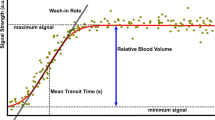Abstract
Objective
To investigate the correlation between microalbuminuria and extravascular lung water in patients in septic shock who require mechanical ventilation for severe respiratory failure.
Design and setting
Prospective, observational, clinical study in the 20-bed intensive care unit of a university hospital.
Patients and participants
25 consecutive patients in septic shock and also in severe respiratory failure requiring mechanical ventilation.
Interventions
Hemodynamic parameters and extravascular lung water were determined by single arterial thermodilution. Together with each hemodynamic measurement the PaO2/FIO2 ratio and urinary microalbumin to creatinine ratio (M:Cr) was measured. Serum C-reactive protein (CRP) and procalcitonin (PCT) levels were also determined daily.
Measurements and results
The EVLW index was significantly higher than normal throughout the study. Microalbuminuria was in the normal range on entry and remained so for the rest of the study period. Serum PCT and CRP levels were significantly higher than normal at every assessment points. No significant correlation was found between M:Cr and either EVLW or PaO2/FIO2 .
Conclusions
In this study patients in septic shock with significantly elevated EVLW had normal urinary M:Cr, and there was no correlation between M:Cr and EWLV, and PaO2/FIO2. Therefore based on the current results routine measurements of microalbuminuria to determine endothelial permeability cannot be recommended in critically ill patients.
Similar content being viewed by others
References
Parillo JE (1993) Pathogenetic mechanisms of septic shock. N Engl J Med 28:1471–1477
Lewis RA, Austen KF, Soberman RJ (1990) Leukotrienes and other products of the 5–lipoxygenase pathway: biochemistry and relation to pathobilogy in human diseases. N Engl J Med 323:645–655
Astiz ME, DeGent GE, Lyn RY, et al (1995) Microvascular function and rheologic changes in hyperdynamic sepsis. Crit Care Med 23:265–271
Fleck A, Raines G, Hawker F, et al (1985) Increased vascular permeability: a major cause of hypoalbuminemia in disease and injury. Lancet I:781–784
Gosling P (1995) Microalbuminuria: a marker of systemic disease. Br J Hosp Med 54:285–290
Gosling P, Shearman CP (1988) Increased levels of urinary proteins: markers of vascular permeability? Ann Clin Biochem 25:150–151
Gosling P, Shearman CP (1992) Can we predict disease severity of acute pancreatitis? Ann Clin Biochem 29:9–10
Gosling P, Sanghera K, Dickson G (1994) Generalized vascular permeability and pulmonary function in patients following serious trauma. J Trauma 36:477–481
Gosling P, Shearman CP, Gwynn B, et al (1988) Microproteinuria: response to operation. BMJ 296:338–339
Sibbald WJ, Short AK, Warshawski FJ, Cunningham DG, Cheung H (1985) Thermal dye measurements of extravascular lung water in critically ill patients. Starling forces and extravascular lung water in the adult respiratory distress syndrome. Chest 87:585–592
Halperin BD, Feeley TW, Mihm FG, Chiles C, Guthaner DF, Blank NE (1985) Evaluation of the portable chest roentgenogram for quantitating extravascular lung water in critically ill adults. Chest 88:649–652
Sakka SG, Rühl CC, Pfeiffer UJ, Beale R, McLuckie A, Reinhart K, Meier-Hellmann A (2000) Assessment of cardiac preload and extravascular lung water by single transpulmonary thermodilution. Intensive Care Med 26:180–187
American College of Chest Physicians–Society of Critical Care Medicine Consensus Conference (1992) Definitions for sepsis and organ failure and guidelines for the use of innovative therapies in sepsis. Crit Care Med 20:864–875
Marshall JC, Cook DJ, Christou NV, Bernard GR, Sprung CL, Sibbald WJ (1995) Multiple organ dysfunction score: a reliable descriptor of a complex clinical outcome. Crit Care Med 23:1638–1652
Diskin CJ, Stokes TJ, Dansby LM, Carter B, Radcliff L, Thomas SG (1999) Towards an understanding of oedema. BMJ 318:1610–1613
Watts GF, Morris RW, Khan K, et al (1988) Urinary albumin excretion in healthy adult subjects: reference values and some factors affecting their interpretation. Clin Chim Acta 172:191–198
Tucker VL, Victorino GP (1997) Methods for studying microvascular barrier function in ischemia-reperfusion injury. Shock 8:8–15
Molnár Z, Szakmány T, Kőszegi T, Tekeres M (2000) Microalbuminuria and serum procalcitonin levels following oesophagectomy. Eur J Anaesthesiol 17:464–465
De Gaudio AR, Adembri C, Grechi S, Novelli GP (2000) Microalbuminuria as an early index of impairment of glomerular permeability in postoperative septic patients. Intensive Care Med 26:1364–1368
De Gaudio R, Spina R, Di Filippo A, Feri M (1999) Glomerular permeability and trauma: a correlation between microalbuminuria and Injury Severity Score. Crit Care Med 27:2105–2108
Abid O, Sun Q, Sugimoto K, Mercan D, Vincent J-L (2001) Predictive value of microalbuminuria in medical ICU patients. Chest 120:1984–1988
MacKinnon KL, Molnar Z, Lowe D, Watson ID, Shearer E (2000) Use of microalbuminuria as a predictor of outcome in critically ill patients. Br J Anaesth 84:239–241
Taylor AE, Moore T, Khimenko P (1994) Microcirculatory exchange of fluid and protein and development of the third space. In: Zikra BA, Oz MO, Carlson RW (eds) Reperfusion injuries and clinical capillary leak syndrome. Futura, Armonk, pp 59–92
Author information
Authors and Affiliations
Corresponding author
Rights and permissions
About this article
Cite this article
Molnár, Z., Szakmány, T. & Heigl, P. Microalbuminuria does not reflect increased systemic capillary permeability in septic shock. Intensive Care Med 29, 391–395 (2003). https://doi.org/10.1007/s00134-003-1651-0
Received:
Accepted:
Published:
Issue Date:
DOI: https://doi.org/10.1007/s00134-003-1651-0




